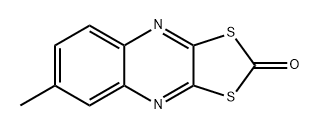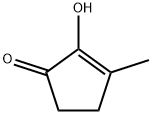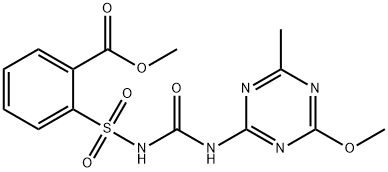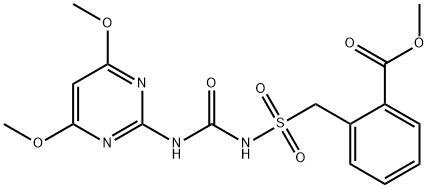Chinomethionate
- CAS NO.:2439-01-2
- Empirical Formula: C10H6N2OS2
- Molecular Weight: 234.3
- MDL number: MFCD00055387
- EINECS: 219-455-3
- SAFETY DATA SHEET (SDS)
- Update Date: 2023-05-15 10:44:00

What is Chinomethionate?
Description
Chinomethionate is a quinoxaline fungicide and acaricide introduced in 1968 to control powdery mildew and spider mites on fruits, ornamentals, cucurbits, cotton, coffee, tea, tobacco, walnuts, vegetables and glasshouse crops. It is nonsystemic, with contact activity only.
Chemical properties
Chinomethionate is a tan to yellow crystals. Soluble in benzene, toluene, and dioxane; insoluble in water. It has been shown to have low toxicity to mammals, birds and bees, but is highly toxic to fish and some aquatic invertebrates.
The Uses of Chinomethionate
Chinomethionat exhibits both acaricidal and fungicidal activities. It is a selective, non-systemic contact fungicide with both protective and eradicant control of powdery mildews on fruits, cucurbits, vegetables, ornamentals, tobacco and glasshouse crops.
Definition
ChEBI: A dithioloquinoxaline that results from the formal condensation of 6-methylquinoxaline-2,3-dithiol with phosgene. It has been used as a fungicide and acaricide for the control of mites and powdery mildew on citrus, vegetables, and walnuts, but is not appro ed for use in the EU.
General Description
Yellow crystals. Non-corrosive. Used as a selective fungicide.
Air & Water Reactions
Hydrolyzed in alkaline solution.
Reactivity Profile
A member of the quinoxaline, dithiolane family.
Hazard
Toxic by ingestion and inhalation.
Flammability and Explosibility
Not classified
Safety Profile
Moderately toxic by intraperitoneal, ingestion, and skin contact routes. A pesticide. When heated to decomposition it emits very toxic fumes of NOx and SOx.
Environmental Fate
Chemical/Physical. Reacts with ammonia forming 6-methyl-2,3-quinoxalinedithiol.
Metabolic pathway
Limited information is available to describe the degradation and metabolic fate of chinomethionat. Hydrolytic cleavage of the dithiocarbonate ring is the primary degradation reaction in water, plants and animals.
Degradation
Chinomethionat was degraded at pH 4,7 and 9 at 22 °C with DT50 values of 10 days, 3.3 days and 3.6 hours, respectively. It is degraded under alkaline conditions to yield 6-methyl-2,3-quinoxalinedithiol (2) (PM) as shown in Scheme 1. Clark and Loeffler (1980) reported the extensive photodegradation of chinomethionat in benzene in a nitrogen atmosphere under UV light to yield dimeric condensation products and benzene insertion products.
Mode of action
Chinomethionate reacts with sulfur-containing amino acids in proteins, thereby disrupting the function of many enzymes and other proteins. Because there is no single target site, target site resistance is unlikely.
Properties of Chinomethionate
| Melting point: | 172° |
| Boiling point: | 476.6±55.0 °C(Predicted) |
| Density | 1.4147 (rough estimate) |
| vapor pressure | 2.6 x 10-5 Pa (20 °C) |
| refractive index | 1.6800 (estimate) |
| storage temp. | 0-6°C |
| solubility | Chloroform (Slightly), Methanol (Slightly, Heated) |
| form | Solid |
| pka | -5.28±0.20(Predicted) |
| Water Solubility | 1 mg l-1 (20 °C) |
| color | Yellow crystals |
| Merck | 13,7048 |
| NIST Chemistry Reference | Quinomethionate(2439-01-2) |
| EPA Substance Registry System | Chinomethionate (2439-01-2) |
Safety information for Chinomethionate
Computed Descriptors for Chinomethionate
New Products
4-AMINO-TETRAHYDRO-PYRAN-4-CARBOXYLIC ACID HCL 4-(Dimethylamino)tetrahydro-2H-pyran-4-carbonitrile 4-Aminotetrahydropyran-4-carbonitrile Hydrochloride (R)-3-Aminobutanenitrile Hydrochloride 3-((Dimethylamino)methyl)-5-methylhexan-2-one oxalate 1,4-Dioxa-8-azaspiro[4.5]decane 5-Bromo-2-nitropyridine Nimesulide BP Aceclofenac IP/BP/EP Diclofenac Sodium IP/BP/EP/USP Mefenamic Acid IP/BP/EP/USP Ornidazole IP Diclofenac Potassium THOMAIND PAPER PH 2.0 TO 4.5 1 BOX BUFFER CAPSULE PH 9.2 - 10 CAP SODIUM CHLORIDE 0.1N CVS ALLOXAN MONOHYDRATE 98% PLATINUM 0.5% ON 3 MM ALUMINA PELLETS (TYPE 73) LITHIUM AAS SOLUTION 2-Bromo-1-(bromomethyl)-3-chloro-5-nitrobenzene 2-Bromo-3-nitroaniline N-(3-Hydroxypropyl)-N-methylacetamide 3-Bromo-6-chloropyridazine 4-ethyl-3-nitrobenzoic acidRelated products of tetrahydrofuran








You may like
-
 Chinomethionate CAS 2439-01-2View Details
Chinomethionate CAS 2439-01-2View Details
2439-01-2 -
 1-Methyl-6-oxo-1,6-dihydropyridazine-3-carbonitrile 98%View Details
1-Methyl-6-oxo-1,6-dihydropyridazine-3-carbonitrile 98%View Details
99903-60-3 -
 1823368-42-8 98%View Details
1823368-42-8 98%View Details
1823368-42-8 -
 2-(3-(tert-butyl)phenoxy)-2-methylpropanoic acid 1307449-08-6 98%View Details
2-(3-(tert-butyl)phenoxy)-2-methylpropanoic acid 1307449-08-6 98%View Details
1307449-08-6 -
 Ethyl 3-(furan-2-yl)-3-hydroxypropanoate 25408-95-1 98%View Details
Ethyl 3-(furan-2-yl)-3-hydroxypropanoate 25408-95-1 98%View Details
25408-95-1 -
 2-Chloro-5-fluoro-1-methoxy-3-methylbenzene 98%View Details
2-Chloro-5-fluoro-1-methoxy-3-methylbenzene 98%View Details
1805639-70-6 -
 1784294-80-9 98%View Details
1784294-80-9 98%View Details
1784294-80-9 -
 Lithium ClavulanateView Details
Lithium ClavulanateView Details
61177-44-4